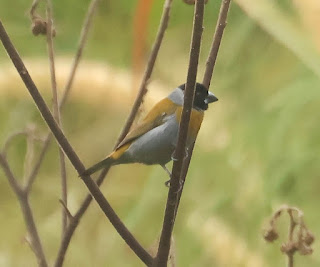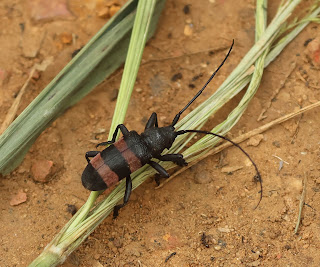Despite not getting our evening meal till around 22:00, we were up at 05:00 to be back in the field for dawn. For the last several years, I've carried a metal coffee press, ground coffee & an insulated mug on foreign trips. This has been great, but it's dependent on being able to get hot water from hotels: on many days in the past this hasn't been possible. I've gone one step further on this trip & also packed a small travel kettle. So the typical morning routine has been to allow enough time for Phil (my room-mate on the trip) & I, to boil enough water for decent coffee to take into the field. The travel kettle proved its worth on this trip & will be another thing I have to fit into my bag on future trips.
It was about a forty-five minute drive to return to the area we had been Birding the previous afternoon in the Damengola Forest. This name is very misleading as the Damengola Forest has been completely logged and the only trees left are those with little or no commercial value. It is a real challenge to find even the smallest patches of surviving trees. The Birds we found were those who were more tolerant of secondary habitats, while the true forest specialists will have gone.
Our first stop was on the main road a few miles before the tracks into the remains of the forest. Here there were a few large trees next to the road, where we saw African Pied Hornbills, Piping Hornbills, Western Bronze-naped Pigeons, African Green Pigeons, Green-crested Turacos and a selection of Barbets & Tinkerbirds. A Gabon Coucal mocked us from the dense secondary growth, with lots of calling, but no sign of this sought after Tick.
African Pied Hornbill: This is the nominate fasciatus subspecies & it was a frequently seen Hornbill in Angola
Yellow-rumped Tinkerbird: This is the leucolaimus subspecies which occurs from Senegal to South Sudan, Uganda, to Southern Democratic Republic of the Congo and North Angola. This was a commonly heard, but rarely seen, Tinkerbird
White-collared Oliveback: This was a species I was really keen & pleased to see. It occurs in the mountains of Eastern Democratic Republic of the Congo, West Uganda, North Rwanda, Burundi & North West Tanzania. There other are isolated populations in North Angola & the Republic of the Congo
As the traffic increased on the main road, we carried onto a different ex-logging track into the forest from the previous afternoon. We drove for many miles along this dirt track, in the hope of finding a reasonable pocket. But we had no luck with any remaining decent forest. We encountered a small village quite a few miles along the track. We found many similar villages throughout the country, along every track we drove. These villages resulted in more miles of surrounding slash & burn subsistence farming which further degraded the remaining habitat. We saw many examples of the locals cutting trees for firewood and shooting the few Mammals, and on occasions the larger Birds, for bushmeat. No wonder, we only found some poorer secondary patches along this track and the Mammals & Birds were often shy.
Western Bronze-naped Pigeon: This species occurs from Sierra Leone to North West Angola, Democratic Republic of the Congo, South West Uganda & Rwanda
Narina Trogon: This is the nominate subspecies which occurs from the Ethiopian highlands to Angola & South Africa. Other subspecies occur in the coastal lowlands of Somalia to Natal (South Africa), Sierra Leone to Uganda and the Democratic Republic of the Congo
Malbrouck Monkey: This species was split from the East & Southern Africa Vervet Monkey at the start of this century
Birding in the forest remains: We drove for many miles along dirt tracks away from the main trying to find some reasonable pockets of forest: but with no joy
Being able to see this surviving large tree indicates how all the surrounding trees have been logged
The problem with having distant large trees and dense secondary bushes by the track was it wasn't easy to get photos of the Birds we were seeing. It was worse as they were constant mocking calls from many Little Greenbuls in these bushes, all of which refused to show themselves. Fortunately, they weren't a Tick for any of us. At least, the Insects were a lot more cooperative.
African Castor: Thanks to my mate Steve Morrison who was able to identify a number of the Butterfly species from my published photos
Spotted Ciliate Blue: Thanks to my mate Steve Morrison who was able to identify a number of the Butterfly species from my published photos
Orange-streak Acraea: Thanks to my mate Steve Morrison who was able to identify a number of the Butterfly species from my published photos
Blue-tipped Jewel: Thanks to my mate Steve Morrison who was able to identify a number of the Dragonfly species from my published photos
Unknown Carpenter Bee Xylocopa sp.: Thanks to my mate Steve Morrison who was able to help narrow down this Bee identification from my published photos
Ceroplesis bicincta: Thanks to my mate Steve Morrison who was able to identify this species from my published photos
Eventually, we gave up on that track and headed off to a lake near to the main road. This proved productive and we saw our first Black-collared Bulbul: a stunning looking Bulbul.
Black-collared Bulbul: This monotypic species occurs from the savanna of Gabon to Angola to South East Democratic Republic of the Congo & North West Zambia
Malachite Kingfisher: This is the nominate subspecies of this widespread Kingfisher which occurs from Nigeria to West Sudan, Uganda & Kenya and South to South Angola, North Namibia, Botswana, Zimbabwe & South Africa. Other subspecies occur in West Africa, the Horn of Africa & on Sao Tome & Principe
African Pygmy Kingfisher: This is the natalensis subspecies which occurs from Angola to South Mozambique & South Africa. It is another widespread Kingfisher with other subspecies which occur over most of Sub-Saharan Africa
After checking the lake, we headed back to the track from the previous evening as they was slightly better remnant patches of forest along that track. We tried walking various stretches before returning to check a small patch of forest that had been left as shade for coffee near the start of the track. Here we saw a family party of Rufous-vented Paradise-flycatchers. This area was one of the better patches of trees.
Rufous-vented Paradise-flycatcher: Not the best of photos, but the black head and crest confirm this is a Rufous-vented Paradise-flycatcher. This is a monotypic subspecies which occurs from South East Nigeria & South Cameroon to Gabon & North Angola
At the end of the day, we headed back to the roadside patch of forest we had started the day in. As we were walking out of the forest in the afternoon, I flushed the only Gabon Coucal we were to see in Angola. Unfortunately, Phil was behind Niall & missed it. We hoped the individual that was calling at the start of the day would show itself. While Niall & Phil were occupied trying to see the Gabon Coucal, Richard & I had an equally unprofitable search for a couple of calling White-spotted Flufftails. They came close, but wouldn't show. Despite a number of attempts over the trip, we had no joy seeing another Gabon Coucal or a White-spotted Flufftail.
























